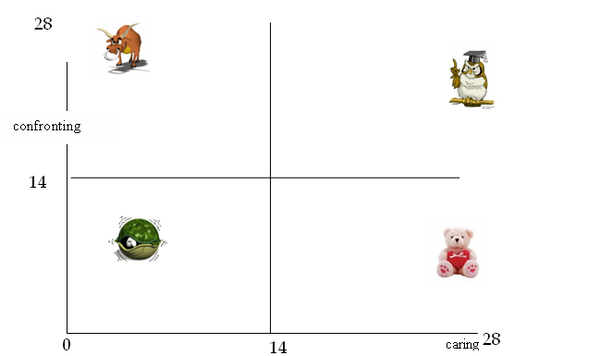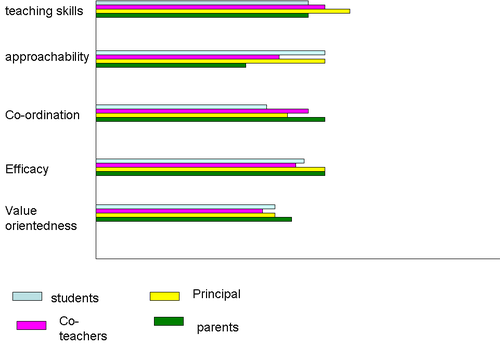Nurturing through feedback
Feedback is essential to ensure that your team members and ,in turn, your institution grows.Feedback can be positive or negative, depending on the performance of a person in a particular task or situation. However, both types of feedback are valuable in the learning process. Generally we receive positive feedback for a skill well done and negative feedback for a skill poorly done. Positive feedback or supportive feedback reinforces or supports the person who is
doing well with a particular skill.It helps them focus on the best
way of doing things and it gives them credit for skills they are mastering and
progress they are making. Corrective feedback points out mistakes and urges us to change.Giving corrective feedback can make a person uncomfortable, but it should be done sensitively. Good leaders point out the behavior and its
bad results, and immediately explain or demonstrate a better way of doing
things.
Remember effective feedback:
• Describes the behavior (positive or negative)that you observed
• Is non-judgmental
• Is given directly to the person
• Is immediately given
• Encourages the person to reflect over the behaviour
• Sets out the next step for the person. Helps to repeat or improvise the behaviour as may be the case
Performance Appraisals
Performance appraisals are necessary to understand each employee’s abilities, competencies and worth for the organization. Performance appraisals rate the employees in terms of their performance. they ensure that the employee gives his best to the institution. As an educational leader, you can use the following technqiues to garner feedback for yourself and the employee.
(i)Self Appraisal: Where the member of staff takes stock of his/her own performance. It is a sort of self analysis and self rating.Here is a sample for Self Appraisal:
| Statement | Always | Very Often | Sometimes | Never |
|---|---|---|---|---|
| 1. I am regular at doing my work. | ||||
| 2. I take pains to upgrade my skills and knowledge in order to teach well. | ||||
| 3. I cater to the intellectual needs of all kinds of students. | ||||
| 4. I cater to the emotional needs of my students. | ||||
| 5. My students consider me as an approachable person. | ||||
| 6. My relations with my colleagues can be termed as cordial. | ||||
| 7. I carry out continual evaluation to check if my classroom objectives are being met. | ||||
| 8. I am aware of my weaknesses as a teacher and make efforts to improve the same. | ||||
| 9. I am aware of my assets as a teacher and use the same fruitfully. | ||||
| 10. I gear my classroom activities in synchronization to the vision and mission of our school. |
The above statements are only indicative. You can modify the same.This kind of self appraisal gives the teacher an insight to his/her own performance.
On basis of this Self Appraisal, the educational leader may carry on an Active Performance Appraisal Conversation.Some important points to consider
1.Have a two way conversation.Try to formulate questions that seek the employee’s ideas and input. This will help the employee feel you value his or her opinions. Give the employee a fair chance to put forward his ideas; let him speak.It gives you a glimpse of what the employee feels about the institutional working.
2. Deliberate on what is important to the employee. After all the employee does the actual work.
3. Affirm the strengths of the employee. Let him know how he is an asset to the institution. If there are liabilities in the person, talk about the liabilities not the person. Let the employee get the impression that both you and he together are going to deal with those liabilities.
4.Emphasize what has been done well so that it will be done even better in the future . Offer only constructive criticisms.
5.Frankly discuss what can be done to improve the ethos of your institution. Ideas and suggestions that come from the employee are practical and should be given due consideration.
Carefronting vs Confronting
However good a leader you may be, you have to offer feedback and suggestions to your staff. More often than not, this becomes an unpleasant experience both for the one giving the feedback and the one receiving the feedback. This is because of the way feedback is given and accepted.
Reflect on your behaviour as leader and honestly answer the following.
Mark 1 for rarely 2 for sometimes 3 for often and 4 for always
1.I am careful not to hurt anyone’s feelings. 1 2 3 4
2.I am sensitive to other people’s spoken words 1 2 3 4
3.I can sense when someone is scared, nervous or sad. 1 2 3 4
4.I consider myself an empathetic person 1 2 3 4
5.I have great amount of tolerance and patience 1 2 3 4
6.I put others before myself 1 2 3 4
7.I speak kindly to all 1 2 3 4
The total score is your score for 'caring'
Now read through these statements and mark as before 1 for rarely 2 for sometimes 3 for often and 4 for always
8.I correct those who are wrong 1 2 3 4
9.I believe in directly telling a person his faults directly 1 2 3 4
10.I am ready to point someone’s inadequacies 1 2 3 4
11.I believe in calling a spade ‘a spade’. 1 2 3 4
12.I believe that we must be corrected in order to improve 1 2 3 4
13.To me work output is more important than relationships 1 2 3 4
14.I am not partial in my behaviour. 1 2 3 4
The total score for statements 8 to 14 is your score for 'confronting'
Plot your score for caring on the X axis and score for Confronting on the Y axis.. See in which quadrant your scores meet.
If your scores meet in the first quadrant, you are low in both caring and confronting, then you are like a 'tortoise'. You do not give due consideration to correcting someone neither are you are a caring person. You have a tendency to shy away from the problem. For a leader, this is something serious. You tend to ignore that problemns exist, you are not really helping your employees grow.
If you are high on caring but low on confrontation then you are a 'teddy bear' very comforting , very warm and caring but you do little to help your employees grow. You are poor at offering feedback. You may seem like a good leader but you are not so in reality. Such an attitude on your part can be detrimental to the institution.
If you are poor at caring and high on confronting, you lie in the zone of the 'bull'.... you offer feedback but it is done with little or no feelings for the person's ego. What you say may be right, but how you say so is not right. the result is that the employees get distanced from you and so in the long run animosity builds up. You need to pepper your feedback with some care.
If you are high on both caring and confronting, you are like a'wise owl' . You have a good knowledge of both management principles and psychology of people. you offer feedback without hurting people's feelings and hence chances of improvement are high. You choose your words, tone and stance carefully.You have combined caring and confronting to develop a wonderful aura of CAREFRONTING.
Carefronting is a combination of caring and confronting. To bring about change in some one we have to confront when necessary. But this is to be done with care. Carefronting means delivering constructive, compassionate feedback to individuals or to an entire group, to expose ineffective behavior and to explore alternatives to that behavior. CareFrontation consists of the truth, as we see it, in the moment, where each participant retains the right to refuse it. The feedback is packaged with caring and love and should be delivered in a way that you would like to receive such feedback. Feedback must be delivered in real-time, because if behavior is left unaddressed too long, it is difficult to recapture and recall accurately. You should CareFront participants only when they are open and receptive to it. So before you offer feedback to a participant, ask them, "May I CareFront you?" Or, "May I offer you some feedback?" If the answer is "NO" then honor that response. Effective behaviors also need to be reinforced. Bombardment with honest feedback, whether it is perceived as corrective or reinforcing, is important to building self-esteem.
Seeking feedback through 360 degree feedback method
While Performance Appraisals generally rate individual employees, the 360 degree feedback can be used for an individual employee as well as the institution as a whole.Feedback is sought from various sources and hence the name 360 degree feedback. This is aslo called as multi rater feedback. In case of an individual teacher, feedback comes from the Principal, the students, parents, alumni, co-teachers and self. Managers and leaders within organizations use 360 degree feedback surveys to get a better understanding of their strengths and weaknesses.
Learn more about 360 degree feedback at http://www.youtube.com/watch?v=OXJkP13xACg
Let us say you want to design a 360 degree feedback for individual teachers in your institution.You would need to seek feedback about their teaching skills, their approachability, co-ordination, efficacy, impact on stakeholders, value orientation, interpersonal skills and usefulness to the institution.
Suppose you generate a tool for each of these areas and seek feedback for each individual teacher from parents, alumni, co-teachers, students and the Principal.A graphical representation of the same would look something like this.
It gives the teacher an idea of what each group(students, teachers, Principal and parents) thinks of him/her and has scope to improve.For example, in the case above the parents do not feel the teacher is quite approachable but the students and Principal think otherwise.Similarly the Principal has a higher opinion regarding the teaching skills as compared to the opinion held by the students. Thus a 360 degree Feedback gives the Principal a glimpse of not just what he/she thinks but also of what others think.

